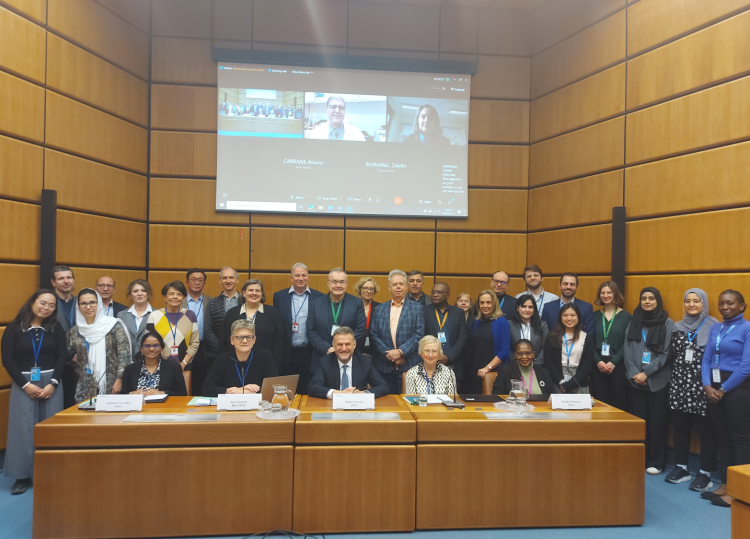The IAEA's expertise in medical physics and dosimetry is enhancing the capacities of countries around the globe to use ionizing radiation in medical procedures safely and effectively, the Scientific Committee of the IAEA and the World Health Organization (WHO) Network of Secondary Standards Dosimetry Laboratories (SSDLs) heard last month.
Held at IAEA Headquarters in Vienna from 11 to 15 March, the Committee's 21st biennial meeting evaluated the IAEA's dosimetry and medical physics efforts in 2022 and 2023; discussed activities for 2024 and 2025; and provided recommendations for 2026 and 2027. The IAEA spotlighted its work on calibrations, auditing, radiation dosimetry and clinical medical radiation physics. Staff presented accomplishments from the previous biennium; planned activities for the current one; and ideas for the next. They also highlighted cross-sectional, collaborative activities as they addressed the committee's questions on IAEA technical outputs - be it on publications, education and training activities, coordinated research projects (CRP) or data, to name but a few.
"Overall, there has been a fantastic, continued achievement", Jan Seuntjens - the Committee's Chair - reflected. "The impact of this is often understated. Initiatives like Rays of Hope cannot be successful without medical physics and the infrastructure that has been set up around the world by the IAEA."
The Committee - which consists of seven internationally renowned experts in the field - meets every two years to assess the IAEA's work and provide independent, external advice. First established in 1986 to review the activities of the IAEA's Dosimetry Laboratory (DOL), the Committee expanded its scope in 1988 to include all IAEA dosimetry and medical physics activities. Its recommendations are not only shared with the Directors General of the IAEA and WHO but also used to inform programme planning.
A Biennium in Review: Key Highlights
In 2022 and 2023, the IAEA/WHO Network of SSDLs calibrated 134 ionization chambers and issued 269 calibration certificates to laboratories in 39 Member States, the Agency reported. Through these critical services, the Network improved accuracy in dosimetry measurements; facilitated traceability between end users (such as hospital staff) and the international measurement system for ionizing radiation; and achieved consistency across all countries. The IAEA also supported the upgrading of 18 SSDLs and the establishment of national calibration laboratories in seven countries.
For its part, the IAEA/WHO postal dose audit programme checked 1429 beams in 503 hospitals - helping with the safety and accuracy of radiotherapy treatments for cancer patients in 78 countries. DOL also expanded its audit options and received an increase in audit requests from Member States.
To further support countries, the IAEA published the guideline National Networks for Radiotherapy Dosimetry Audits. This resource joined four SSDL Newsletters and ten other publications, including:
- Handbook of Basic Quality Control Tests for Diagnostic Radiology, which was the most downloaded IAEA book in 2023;
- Artificial Intelligence in Medical Physics: Roles, Responsibilities, Education and Training of Clinically Qualified Medical Physicists, which helps medical physicists around the world meet the challenges of the present and the demands of the future; and
- Dosimetry in Brachytherapy - An International Code of Practice for Secondary Standards Dosimetry Laboratories and Hospitals, which will have significant impact on the quality and standardisation of radiation globally.
Among other things, the IAEA continued its dosimetry and medical physics research under five CRPs; assisted on 46 national, regional and interregional trainings; and supported nearly 400 technical cooperation projects, it was reported.
The IAEA also helped bring attention to an urgent global need. Data from its DIrectory of RAdiotherapy Centres (DIRAC) - the most comprehensive database on radiotherapy resources - enabled the World Intellectual Property Organization to reveal an alarming trend through its 2023 Global Innovation Index: cancer cases requiring radiotherapy are outpacing available technology. DIRAC data also show that only 20.9 per cent of countries met the minimum radiotherapy resource requirements in 2022.
This disparity is why the IAEA launched its Rays of Hope initiative, aimed at increasing access to radiotherapy in countries with little or no access to this technology. In supporting that flagship initiative's implementation, IAEA dosimetry and medical physics experts provided technical input to several projects; helped outline the process for setting up Anchor Centres; and conducted in-depth reviews of potential centres. They also contributed to the IAEA's efforts in securing collaborative partnerships with academia and industry.
"The IAEA's continued success has no doubt been possible because of its greatest resource: its staff. Through their dedication, professionalism and commitment, they have supported Member States and played a vital role in implementation - from providing technical expertise in technical cooperation projects worldwide to facilitating the establishment of Rays of Hope Anchor Centres," May Abdel-Wahab, the Director of the IAEA Division of Human Health, emphasized. "They have advanced and ensured high-quality care through highly recognised guidance documents, publications and award-winning research."
A full report of the Committee's proceedings and recommendations will be published in a forthcoming IAEA SSDL Newsletter.

IAEA staff together with members of the Scientific Committee of the IAEA/WHO Network of SSDLs. (Photo credit: Z. Msimang/IAEA)






